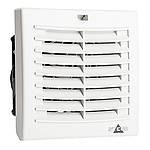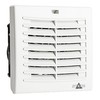Active vs. Passive Enclosure Cooling
Featured Product from STEGO

“ISN’T COOLING AN ENCLOSURE EXPENSIVE?” AIR CONDITIONING IS NOT THE ONLY OPTION!
My Dad is the smartest man I know. He majored in Physics and graduated near the top of his class, in an era before laptops, graphing calculators, and the Internet. Even more amazing to me,
he did all his calculations using a slide rule (pictured left). I now have my Dad’s slide rule proudly on display in my office; it reminds me of my Dad and all the lessons he taught me. Today we rely on computers to do the heavy lifting when calculating heat transfer rates and other thermodynamic data. Thank goodness we don’t have to remember how to use a slide rule!
Here’s the key, though – whether using a slide rule or your iPad, there are fundamental principles that still must be respected, no matter how you get to the answer. In other words: how you get to the solution doesn’t matter. All that matters is that you make the right engineering decision. That choice needs to consider the system requirements AND the total system cost.
In terms of electronics thermal management, we need to challenge certain assumptions to design the most cost-effective solution that will protect your device from temperature extremes.
Changing the paradigm: Active vs. Passive Enclosure Cooling
Air conditioning is considered active cooling. Like in your home in the heat of summer, you simply set the temperature and the unit maintains it, just like you programmed. Simple right? Not so fast!
As humans, we like a specific temperature to function at our peak. The same applies to the electronics inside your enclosure. However, although air conditioning may work fine in your design, it might be overkill. Consider these factors:
Power requirements:
An air conditioner will require the most power compared to other (e.g., passive) technologies.
Cost:
Active cooling solutions cost the most initially and on an ongoing / maintenance basis.
True system requirements:
Many times, your electronics need only to be slightly cooled, not requiring a very tight window of control or not requiring a temperature significantly below ambient.
Condensation risk:
Air conditioning removes humidity from the air, but that condensate has to go somewhere. So you’ll have to engineer some way to handle this thermal “waste stream.”
A filter fan may be a better choice. Filter fans are used to provide cooling via forced air circulation. The interior temperature of an enclosure can be reduced by channeling cooler, filtered outside air into the enclosure, and pushing hot air out of the enclosure. The resulting airflow prevents the formation of localized hot pockets and protects electronic components from overheating.
A filter fan can protect your enclosure from high-temperature exposure with:
- Fewer power requirements.
- Less cost to install and maintain.
- Less mess, with no troublesome condensate to be managed.
Our takeaway: don’t always assume you need to design an air conditioner for your electronics enclosure.
Follow us on:
STEGO Elektrotechnik GmbH
STEGO - Perfect Thermal Management: Since it was founded in 1980, STEGO Elektrotechnik in Schwaebisch Hall, Germany, has been developing, producing and selling an evergrowing range of products for the protection of electric and electronic components. All STEGO products for cabinets and enclosures - heaters, fan heaters, filter fans, LED-lamps, thermostats, hygrostats and accessories - are aimed at reaching optimum climatic conditions in the most varied environments, en-suring that all sensitive components work reliably at all times. STEGO is now represented at 12 locations and by more than 200 sales partners worldwide.







